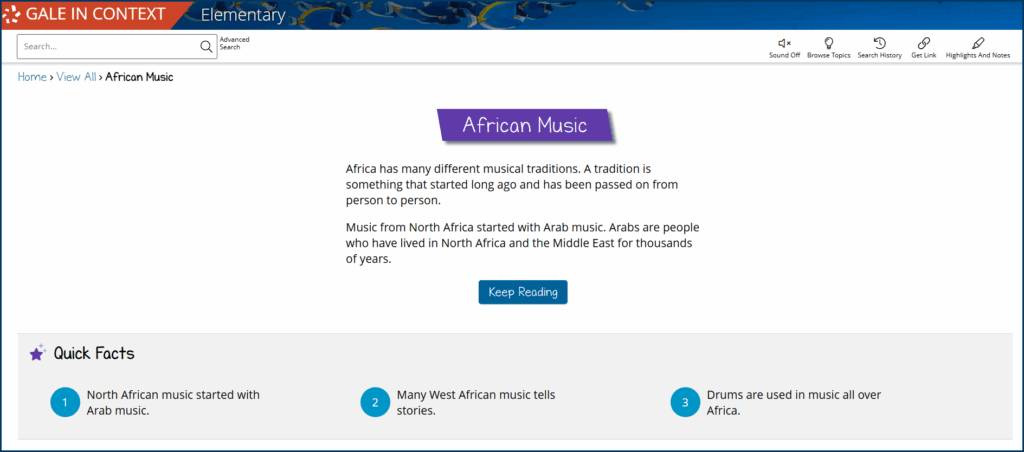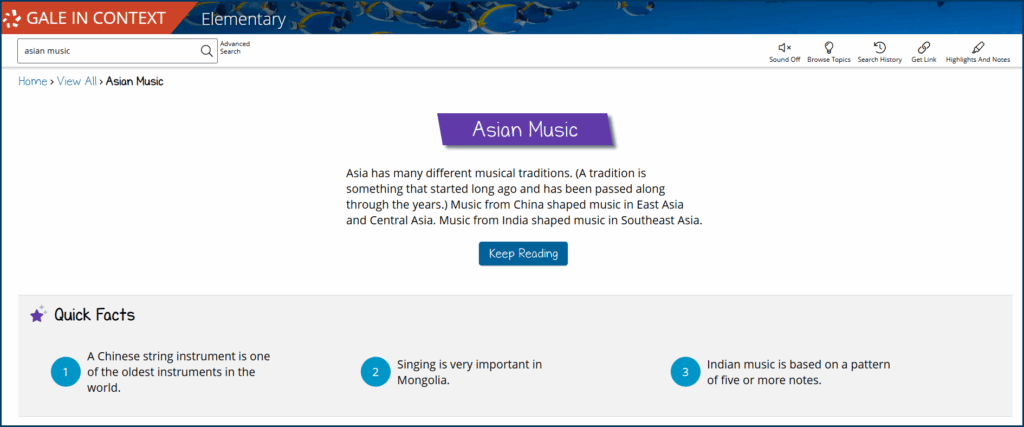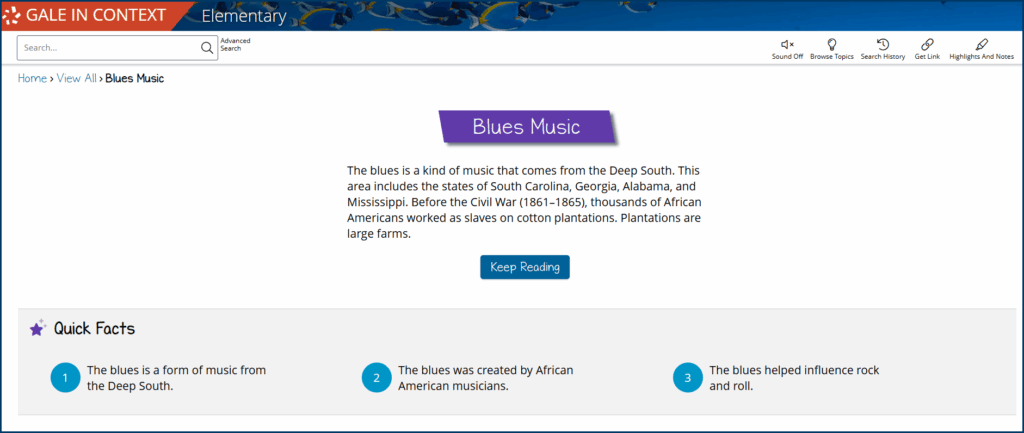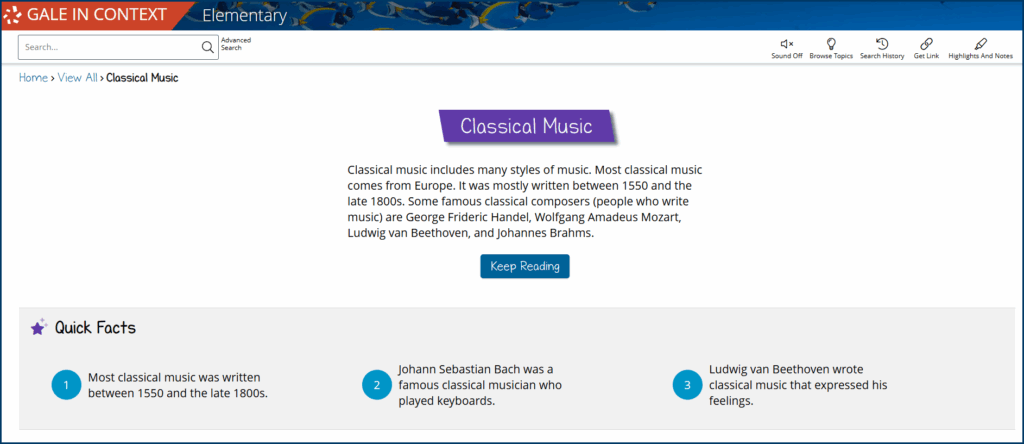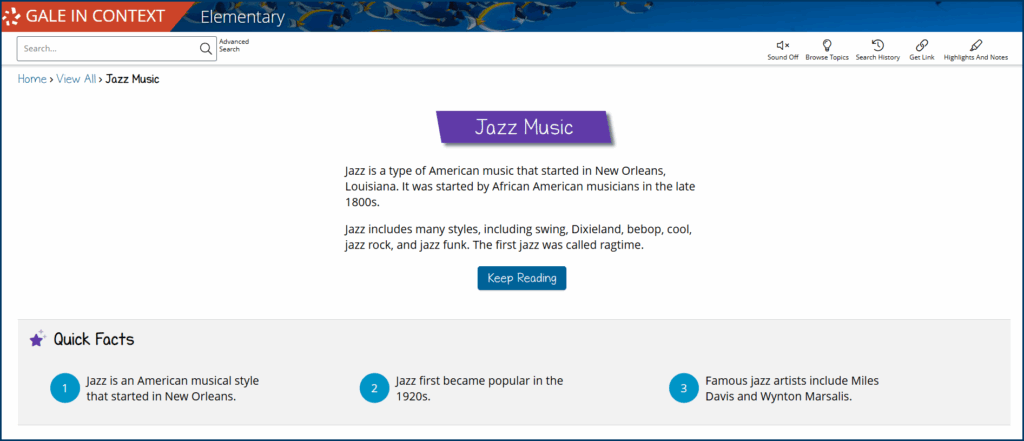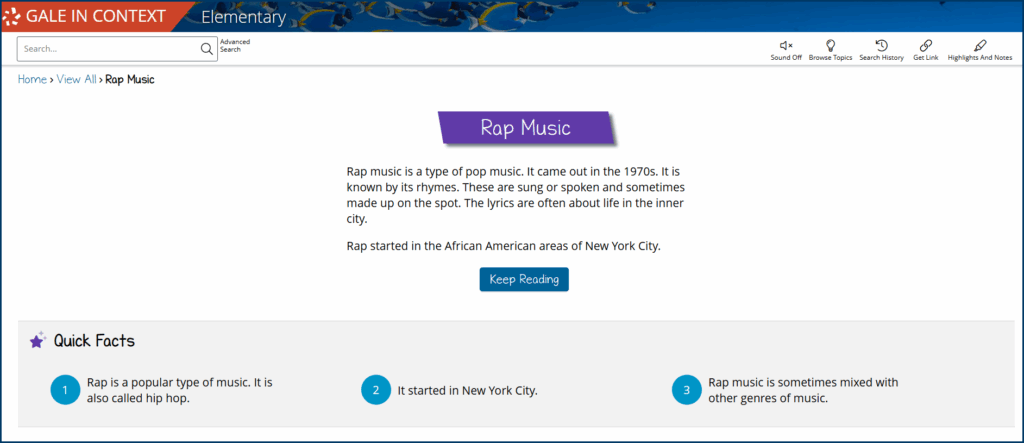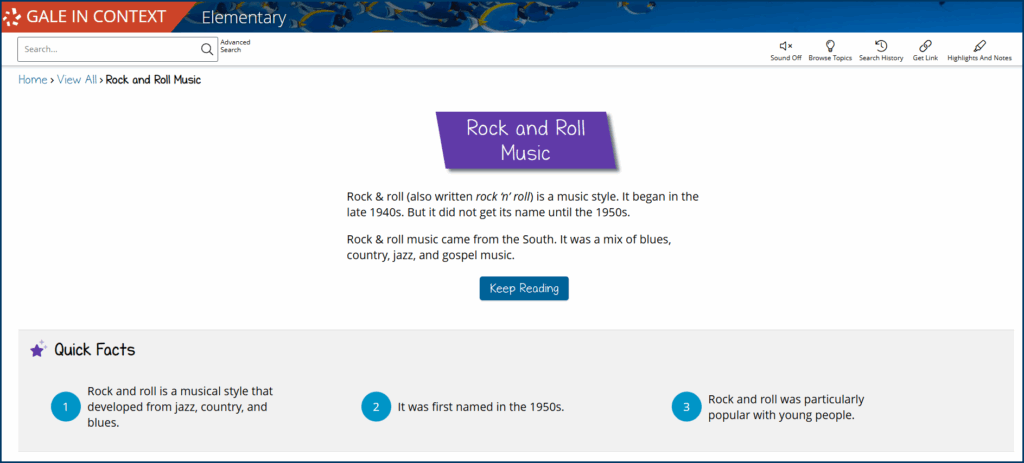| By Gale Staff |
Most students already have a favorite song. They might not know what genre it falls into—or even who the artist is, especially in lower elementary—but they know how it makes them feel. Elementary educators can help young learners build on that connection during International Music Day on October 1, prompting critical thinking about how music transcends borders and spans time.
Gale In Context: Elementary puts a world of music and culture within reach for young researchers. Music-related entries span continents and centuries, featuring short videos that allow students to see and hear what makes each genre distinct. The platform’s magazine, reference, and audio content create a research experience that feels approachable and fun, while encouraging thoughtful classroom discussion. Toggles to adjust Lexile levels and built-in text-to-speech support enables wider participation and deeper engagement.
Let’s explore a few of the genres featured in Gale In Context: Elementary and share ideas to spark student inquiry.
Give Students the Language to Talk About Music
If your students have ever tapped their toes to a beat or hummed along without knowing the words, they already have a basic sense of how music works. That instinct is a great starting point, but a shared vocabulary gives students the tools to identify characteristics of music across cultures. Introducing a few foundational terms early on can help them describe what they hear with greater confidence and curiosity.
- Genre: A style or type of music—like jazz, classical, or rap—that follows certain patterns or traditions.
- Harmony: The combination of different notes played or sung simultaneously to blend the sounds. Groups like Simon & Garfunkel and The Beach Boys used harmony to make their voices sound more interesting when they sang together.
- Improvisation: Making up music as you go. One famous example is jazz musician Louis Armstrong, who made up trumpet melodies and nonsense syllables (called scat singing) instead of following written notes.
- Lyrics: The words in a song.
- Melody: A sequence of musical notes that make up the main tune of a song. In “Twinkle, Twinkle, Little Star,” the melody begins with the notes C–C–G–G–A–A–G—the part you sing as “Twinkle, twinkle, little star.”
- Note: A single musical sound. Notes can be high or low, short or long. When you play or sing several notes in a row, they can form a melody. Musicians write notes down using symbols so they know what to play.
- Rhythm: The pattern of beats or timing in music that helps organize the sound. In “We Will Rock You” by Queen, the stomp-stomp-clap pattern is the rhythm.
Consider creating an illustrated word wall that students can reference as you progress through your music unit, helping them internalize new vocabulary. This will give students repeated, purposeful encounters with domain-specific terms as they explore new genres, making it easier for them to apply those words in context.
Discussion Prompt:
Once students have a shared vocabulary, invite them to think about how music fits into their own lives. As students share, bring their attention to similarities and differences across musical experiences while reinforcing that there’s no “right” way to enjoy music.
- What’s your favorite kind of music? How does it make you feel?
- Do you listen to different music when you’re doing different things, such as reading, doing chores, or playing with friends?
- Are there any songs you and your family listen to together? What do they remind you of?
- How does the music you like sound different from the music your parents or grandparents enjoy?
Musical Genres From Around the World
When you listen closely, musical genres offer clues about the people and places they come from. With the resources available in Gale In Context: Elementary, young learners can begin to identify those patterns and make cross-cultural connections through the history of musical migration.
African
Some of the earliest evidence of music comes from Africa, where ancient rock art shows people dancing and playing instruments thousands of years ago. That long tradition continues in many communities today, where music is used to pass down stories and values. In West Africa, for example, griots are trained from childhood to preserve oral history through music and song.
Regional and cultural variations in African music are wide-ranging, but two of its most foundational features are polyrhythm and drumming. In Ewe drumming, for instance, one drum keeps time while others layer in offbeat patterns that fill the spaces in between. As different patterns play off one another, they create a structure that naturally supports call and response—one voice or instrument leads, and others answer—making African music a communal, conversational experience.
Asian
Asia is home to hundreds of cultures, each with its own musical traditions. Because of this, there’s no single “Asian sound.” In ancient times, Chinese imperial court music spread along the Silk Road, influencing ceremonial music in neighboring countries through its five-note (pentatonic) scale and ritual instruments, such as bronze bells (pyeonjong) and stone chimes (pyeongyeong). Japan’s gagaku, the oldest continuously performed orchestral tradition in the world, and Korea’s gak both reflect this legacy in their formal structure and use of similar percussion instruments.
In northern India, Hindustani music followed a different path. Shaped in part by ancient Persian influences, it is especially known for its use of ragas (melodic frameworks), and talas (rhythmic cycles). Musicians improvise within these structures to evoke specific moods, times of day, or seasonal themes, often while playing the sitar, a long-necked string instrument.
Blues
The blues didn’t begin in concert halls but in cotton fields, sung by enslaved people in the rural South as they toiled long hours under brutal conditions. When one person sang a line, others nearby would answer back, creating a shared rhythm that made the work more bearable and reminding everyone they weren’t alone.
Early blues musicians took these work songs, shaped by real-life challenges, and added music they developed themselves using makeshift instruments like washboards or stomp boxes to keep the beat. Ma Rainey, known as the “Mother of the Blues,” was one of the first performers to bring the raw sound of the blues to a public stage. Her lyrics addressed difficult topics like bad luck and lost love—experiences many in the audience had lived through themselves.
Classical
Western classical music in Europe has roots in plainchant, a musical tradition in medieval monasteries, and religious pieces passed down through neumes, an early form of musical notation used by monks to preserve sacred melodies. Over time, classical music expanded beyond the church into royal courts.
Over the centuries, classical music evolved through several major periods, each with its own distinct style and influential composers.
- Renaissance (c. 1400–1600): Josquin Desprez, Ave Maria
- Baroque (c. 1600–1750): Johann Sebastian Bach, Brandenburg Concertos
- Classical (c. 1750–1820): Wolfgang Amadeus Mozart, Eine kleine Nachtmusik
- Romantic (c. 1820–1900): Ludwig van Beethoven, Symphony No. 5
Jazz
Jazz began in the early 1900s in cities like New Orleans, where musicians combined ragtime, brass band marches, spirituals, and blues. Like the blues, jazz often uses call and response—one instrument plays a phrase, and another answers or expands on it. However, while blues follows repeated vocal lines and steady rhythms, jazz opens up space for instrumental solos and improvisation. A trumpet might introduce a melody, and the piano responds with a variation; meanwhile, the bass and drums maintain the steady rhythm underneath.
As jazz gained popularity, it adopted new styles and genres. Louis Armstrong became known for his expressive trumpet playing and vocal improvisation in the 1920s. In the 1930s, Duke Ellington’s swing band brought jazz into the ballroom. Later, musicians like Charlie Parker and Dizzy Gillespie developed bebop—a faster, more complex form of jazz.
Rap
When hip-hop began taking shape in 1970s New York, rap was just one part of a larger culture that included breakdancing and DJing. In the Bronx, artists like DJ Kool Herc used turntables to loop drum breaks from funk records, while MCs (masters of ceremony) like Grandmaster Flash and Kool Moe Dee delivered fast-paced rhymes over the beat.
Some early tracks were playful, full of clever rhymes and crowd interaction. Others became a means to discuss serious political topics, particularly in the work of groups like Public Enemy.
Rock and Roll
In the 1950s, American teenagers were drawn to the high-energy rhythms of electric blues and R&B. Artists like Chuck Berry and Sister Rosetta Tharpe built on those styles, adding louder guitars and more aggressive vocals to create rock and roll. The genre quickly became a symbol of youth culture, giving teens a sound of their own at a time when they were beginning to push back against the expectations of adults.
By the late 1960s, rock had splintered into styles shaped by the era’s social and political unrest. Psychedelic rock captured the spirit of the counterculture and resistance to the Vietnam War. In the 1980s, punk bands such as the Ramones emerged in response to economic anxiety and political cynicism, channeling frustration through stripped-down sound and raw energy. The 1990s brought grunge, and with it, Nirvana and Pearl Jam, who voiced a generation’s disillusionment with consumerism and conformity.
Music provides students with a means to explore their identity, history, and culture. With the range of materials available through Gale In Context: Elementary, teachers can weave all these threads together in a single, cohesive lesson.
Contact your local Gale representative to learn how we can support your cross-cultural lesson planning.


